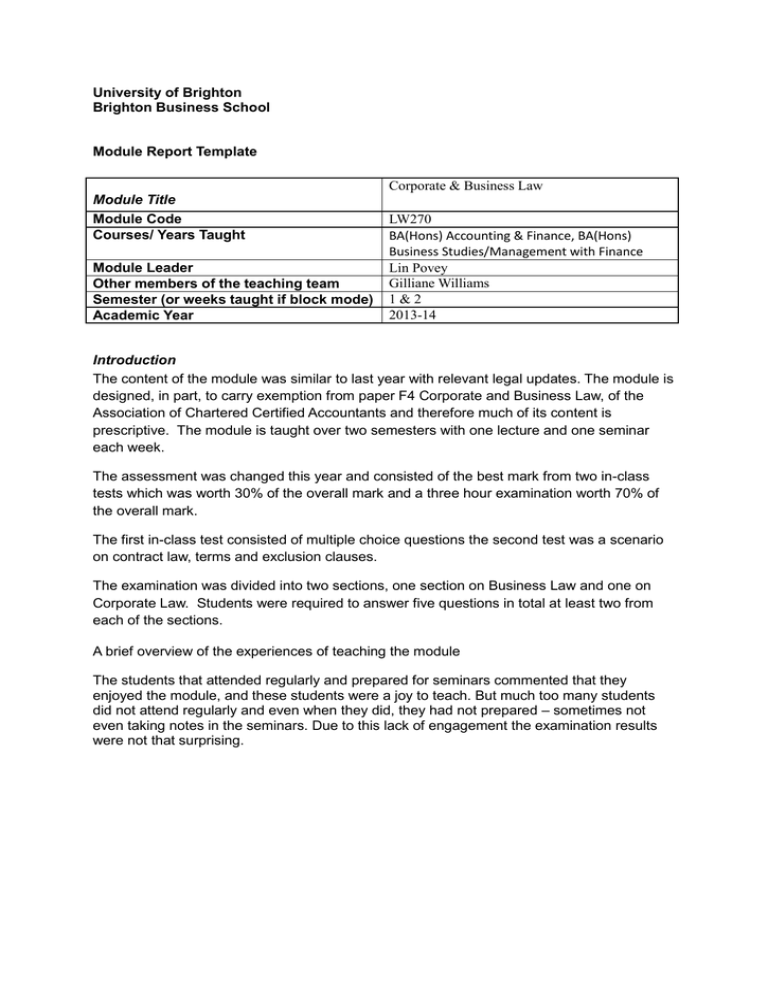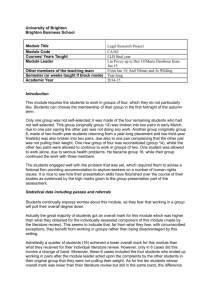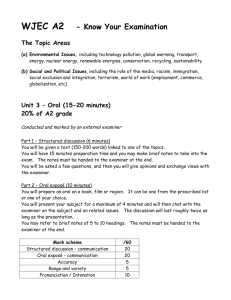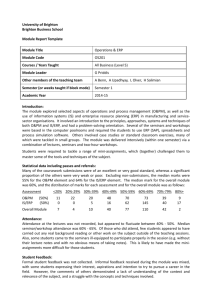LW270 Module Report 13-14
advertisement

University of Brighton Brighton Business School Module Report Template Corporate & Business Law Module Title Module Code Courses/ Years Taught Module Leader Other members of the teaching team Semester (or weeks taught if block mode) Academic Year LW270 BA(Hons) Accounting & Finance, BA(Hons) Business Studies/Management with Finance Lin Povey Gilliane Williams 1&2 2013-14 Introduction The content of the module was similar to last year with relevant legal updates. The module is designed, in part, to carry exemption from paper F4 Corporate and Business Law, of the Association of Chartered Certified Accountants and therefore much of its content is prescriptive. The module is taught over two semesters with one lecture and one seminar each week. The assessment was changed this year and consisted of the best mark from two in-class tests which was worth 30% of the overall mark and a three hour examination worth 70% of the overall mark. The first in-class test consisted of multiple choice questions the second test was a scenario on contract law, terms and exclusion clauses. The examination was divided into two sections, one section on Business Law and one on Corporate Law. Students were required to answer five questions in total at least two from each of the sections. A brief overview of the experiences of teaching the module The students that attended regularly and prepared for seminars commented that they enjoyed the module, and these students were a joy to teach. But much too many students did not attend regularly and even when they did, they had not prepared – sometimes not even taking notes in the seminars. Due to this lack of engagement the examination results were not that surprising. Statistical data including passes and referrals Examination Total number of students sitting the exam – 137 The breakdown is as follows: 1 2 3 4 5 6 7 8 12 9 9 10 11 11 8 12 ### 50 Average Mark 18 18 18 18 18 18 16 18 0 88 Max Mark 2 0 0 0 0 0 0 1 0 4 Min Mark 47 36 37 38 43 43 33 47 ### 50 Average % 72 72 72 72 72 72 64 72 0 88 Max 8 0 0 0 0 0 0 4 0 4 Min 13 18 19 20 18 17 17 16 ### 18 19 < 35 15 35 - 39 24 40 - 49 32 50 - 59 28 60 - 69 19 >= 70 St Dev As you will see from the table above the average mark was 50%, (2013 – 50%) with a maximum mark of 88% (2013 – 90%) and a minimum mark of 4% (2013 - 0%). There were a much higher number of fails for the examination this year which is very disappointing, although there is a good spread of marks and 19 students achieving a first, which was the same as 2013. Analysis of answers, all marks are out of 20 Question 1. This was a popular question on the English legal system, delegated legislation and statutory interpretation, the average mark was 12, the highest 18, and the lowest 2. The students that did not do well neglected to give examples or case authority. Question 2 This was a contract law question on offer and acceptance and was the most popular question. The average mark was 9, many of the students missed the comparison between a request for information and counter offer, and also confused the postal rules and applied these to revocation as well as acceptance. Question 3 This was a question on breach of contract and remoteness of damage, again the average mark was 9, it was generally well answered with relevant case law, however some students mistook this for a question on negligence. Question 4 This was a tort question on professional negligence. The average mark was 10 and there were some very good answers, some lacked relevant case authority. Question 5 This question was on the company as a separate entity and lifting the veil of incorporation. It was a popular question. The average mark was 11 there were some very good answers, some however lacked authority. Question 6 This was a question in two parts on the articles of association, part a was well answered, but part b on the application of the articles caused confusion for some students. The average mark was 11. Question 7 This question was in 3 parts a) fixed and floating charges, b) winding up, c) Fraudulent and wrongful trading. Students could chose any 2 from the 3. The average mark for this question was 8, the main area for problems was part b) – fixed and floating charges, many students confused this with interest rates being fixed or variable. There was also confusion on parts a) and c). Question 8 This was the second most popular question and was on insider dealing. This lecture and seminar was one of the last, so probably still fresh in students mind and it is a topic that students always seem to be interested in! The average mark was 12, most students demonstrated an understanding in the application of the law but answers often lacked statutory and case authority and many missed the defences and penalties. Coursework The first in-class test consisted of multiple choice questions the second test was a scenario on contract law, terms and exclusion clauses. The first multiple choice test was very well attended by 135 students, the maximum mark was 80% and the minimum mark 27%. Students were advised that the best mark of the two tests would count as the overall mark for coursework. Several students that achieved very good marks decided not to sit the second test even thought they were advised to do so as this would be more relevant to exam type questions. In all 95 students sat the second test on terms and exclusion clauses in contract law. The highest mark was 90%, the lowest 5% and the average 51%. As a result of the high marks for the first multiple choice test, and the probability that this gave students an impression that they were understanding the material well, it has been decided that the questions for the first test will need to be more challenging and include one application questyion for the next academic year. Attendance: Attendance for the lecture was generally poor, probably because it was at 9am. Seminar attendance was patchy, some weeks good, others very bad, especially when coursework was due in or tests were taking place in other modules. The students that attended regularly enjoyed the module, although preparation for seminars was poor, apart from a core group in each seminar who engaged well. Student Feedback: This was conducted at course level and is not yet available. Method of returning feedback: Please indicate which means of returning feedback were used: Gradecentre comments Gradecentre attached feedback sheet Turn It In: cover sheet comments Turn It In: rubric Turn It In: voice feedback Turn It In: in line comments Turn It In: quick marks Other (please specify) Test results handed back in class with feedback on the work. Marks also put onto grade centre. X Module/component organization There are no changes planned for the coming academic year External Examiner Comment A short commentary on issues raised by external examiners and action taken as a result. This will need to be added after external examiner comment has been received. Action Plan To make some changes to the first test and introduce an application question alongside the multiple choice questions. Routing of report: An electronic copy of this module report should be submitted to the administrative office responsible for the courses where the module is delivered at the same time that marks are submitted to the office, so (where necessary) the report can be circulated to the relevant external examiner(s), with sample work, prior to the meeting of the examination board. The office will also upload copies of module reports into the Quality Folder on BBS storage, so that they can then be accessed on Studentcentral. Where an external examiner makes comments about a module at an examination board or in their external examiner report, these comments may be incorporated into, and responded to, in a revised module report, which is then forwarded in electronic form to the School Quality Director (SQD) and the relevant subject group leader. The module leader’s response should be conveyed to the external examiner by the person designated to formally respond to the particular external examiner (who will normally be a subject group leader or course leader). The SQD will arrange for the relevant office to upload a revised copy of the module report into the Quality Folder in BBS storage. The SQD will monitor reports, and will liaise with subject group leaders about any outstanding issues.





